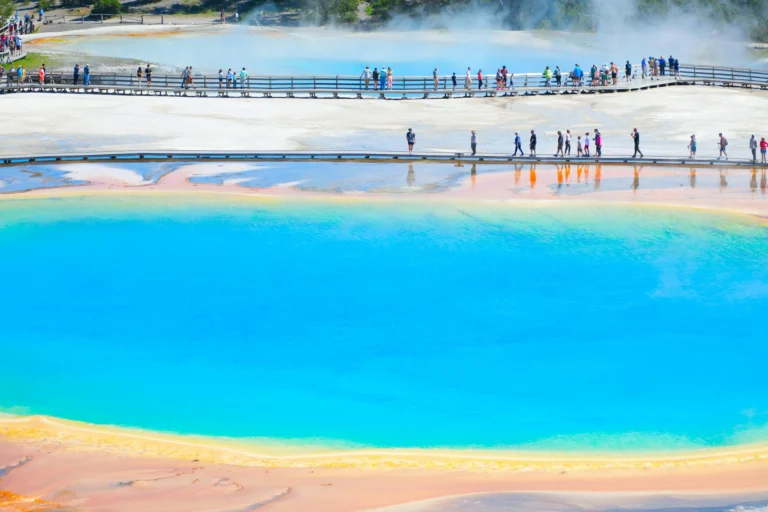- Overview of the Continental Divide Trail:-
- States Along the Continental Divide Trail:-
- Best Sections to Hike on the Continental Divide Trail:-
- Challenges of the Continental Divide Trail:-
- Permits and Regulations Required for Hiking on the Continental Divide Trail:-
- Planning Your Continental Divide Trail Adventure:-
Overview of the Continental Divide Trail:-
In today’s generation, where physical activity has become minimal or almost negligible, going on treks and hikes can spice up your life. It can help you remain physically fit and take some time to explore nature. One such challenging yet fascinating hiking spot is the Continental Divide Trail. This trail covers a huge area, about 4000-4500 kilometers (or 3000-3500 miles).
The Continental Divide Trail lies along the US border with Chihuahua (Mexico) and the border of Alberta (Canada). It has an interesting history. In 1965, President Lyndon Johnson proposed forming this trail for establishment near Colorado, the origination of the idea of this trail. After all the discussions, debates, and execution, the trial was finally formed in 1978.

States Along the Continental Divide Trail:-
Throughout the Continental trail, a total of 5 states are included and well-established. These states are Wyoming, Colorado, New Mexico, Idaho, and Montana (not according to the sequence). Every state has its own benefits and challenges that they contribute to the trail and that is why hikers face different types of difficulties while hiking through these states.
The scenic sections of New Mexico state in this trail are considered the best section of the whole trail. This section includes Gila Wilderness, Animas and Playus Valleys, Silver City, Mount Taylor, and Crazy Cook Monument. The next is Colorado which covers about 1100-1200 kilometers or 700-800 miles of the trail. Colorado is known for its wild rocky mountains that pose more challenges for the hikers.
With the Great Divide Basin and Yellowstone comes Wyoming, the next state destination of the trail. Some topmost notable and scenic spots of Wyoming are Cirque of the Tower, Bridger Park, Rawlins, Wind River Range, and so on. After Wyoming, some of the best sections of the Idaho and Montana Border that come along this trail are Chief Joseph Park, North Fork of Sheep Creek, Homer Young’s Peak, Lehmi Pass, etc.

Best Sections to Hike on the Continental Divide Trail:-
The overall concept of the Continental Divide Trail is beauty and a natural miracle. Even though the challenges of hiking this trail are immense, people can suffer it all happily to get the mesmerizing end result from life. The Wind River Range in Wyoming is among the best and leading sections of this trail. Its sceneries and the Cirque of the Towers are very popular.
In Montana, the Beartooth Plateau is a challenging pass with high-alpine lakes. The San Juan Mountains in Colorado and famous remote sections of Idaho and New Mexico are also included in the list of best sections for hiking on the Continental Divide Trail.
Gear and Preparation for Hiking on the Continental Divide Trail:-
Gearing up for your Continental Divide Trail hike, you should properly follow the continental divide trail backpacking tips for beginners as well as for professionals. Along with important hiking materials, effective physical conditioning is also required to prepare for this trail. Physical training should prioritize building endurance, strength, and cardiovascular fitness through activities like running, strength training, and hiking.
Ensure that things you have packed are lightweight & durable gear, sturdy boots, a reliable sleeping bag, a water filtration system, etc. These materials will help people not only hike for one day but sustain for even more days on the trail & enjoy the beauty around.

Challenges of the Continental Divide Trail:-
The answer to the question of how difficult is the continental divide trail to hike is that it presents a formidable challenge for even the most experienced hikers. Its:
- Remote location.
- It Often traversing vast stretches of wilderness with limited human contact
- demands a high degree of self-resilience and careful planning. The trail is never well-marked and that is why it requires excellent navigation skills & the ability to interpret maps and terrain.
- The elevation gains and losses of the trail are sometimes huge, with steep descents and high passes. This tests both the mental and physical endurance of people and that is why being strong from both these aspects is crucial to completing this hike.
On the other hand, weather conditions can also be unpredictable and extreme, ranging from thunderstorms and scorching heat to heavy snow and freezing temperatures. These factors when combined with the rugged and unforgiving terrain make the continental divide trail a truly rewarding and demanding hiking spot .

Permits and Regulations Required for Hiking on the Continental Divide Trail:-
There is a very complex yet necessary web of permits and regulations required for hiking the Continental Divide Trail. We have mentioned in detail in the continental divide trail complete hiking guide and should be properly understood. The whole trail cannot be covered in a single permit and different sections need different types of permits.
For national parks like Yellowstone and Glacier, people are required to take a backcountry camping permit, a recreation permit for exploring the Blackfeet Indian Reservation, and wilderness permits for hiking other areas of the trail. It is important to research and obtain all necessary permits in advance because many permits have quotas and require prior reservation to confirm permits.

Inspiration and Stories about the Continental Divide Trail:-
Before starting to think about what to pack for the continental divide trail, you first need to understand its significance and specialties. The Continental Divide Trail is a source of inspiration and adventure for a lot of professional and beginner-level hikers. There are hundreds of stories of people who have pushed their physical and mental levels to hike on this trail, which inspires thousands of others to do so too.
From stories of overcoming personal challenges to encounters with wildlife & experiencing breathtaking landscapes, this trail has a unique ability to captivate and inspire those who dream of embarking on a journey of self-discovery & exploration.
Planning Your Continental Divide Trail Adventure:-
The first and most important thing that people should not forget while making their plans is the best time to hike the continental divide trail.
Some other important things are –
- Thorough Route Research:
Make a thorough route research about the whole trail and then plan your tour accordingly. This will help you know the difficulty level of the trail and also get all the necessary permits beforehand. Researching authentic websites will help you stay updated about any changes in the hike timings or any special requirements needed at the last minute.
- Connect and Interact with the Continental Divide Trail Community:
Join the official group of the Continental Divide Trail community and interact with them. Solve all your doubts beforehand and rejuvenate yourself for hiking the trail with complete enthusiasm.

- Select Appropriate Clothing:
As a part of planning for the Continental Divide Trail hike, selecting the right clothes is crucial. Make sure to include all the necessary clothing according to the changing weather conditions to be properly prepared beforehand.
Considering all the above things before executing your plan of hiking the Continental Divide Trail will be very helpful for people. This way, they will be prepared for various challenges that they come across during the hike and will not have to worry too much about the same. Keeping themselves out of trouble will be possible with the help of proper planning and execution of the continental trail hike.

FAQs:-
1.How much length of the Continental Divide Trail can be determined?
The total length of the Continental Divide Trail is approximately 5000 kilometers starting from Mexico and stretching to the Canadian border.
2. What is considered the ideal time for hiking the Continental Divide Trail?
The most ideal time to hike the Continental Divide Trail is from June to September months. Weather conditions during these months are very mild and the melting of snow has also just occurred.
3. How to recognize some important resupply points on the Continental Divide Trail?
Resupply points such as Lander, Missoula, Santa Fe, Dubois, and Salida. On these points, hikers can stop by to have some rest, drink water, eat some energy-gaining food, and then move ahead with their hiking journey.

4. Are there any challenges that people will have to face on their Continental Divide Trail Hike?
As the Continental Divide Trail is a little difficult, hikers may have to face some challenges during their hike. These challenges may include rugged terrain, fluctuating weather conditions, trouble while hiking in remote sections, etc. People should be well-prepared even before starting their hikes so that they can address these troubles properly and overcome them without any difficulty.
5. List down the states that are included in the Continental Divide Trail.
There are a total of 5 states that are included in the Continental Divide Trail. These states are Idaho, New Mexico, Wyoming, Montana, and Colorado. It is observed that the whole trail passes primarily through these 5 states and hiking the trail also means that people can get the views of these states along with it.

Conclusion:-
The Continental Divide Trail is a very perfect example of the beauty of nature to its fullest. It has remarkable hiking destinations, landscapes, sceneries, and other fascinating spots that people would definitely love to visit.
So, don’t forget to consider the Continental Divide Trail at the topmost while making any hiking plan or nature-exploring plan.




